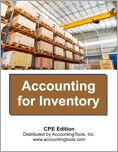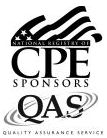Accounting for Inventory (CPE Course)
CPE Credit: 13 hours
Course Type: Downloaded PDF materials with online test
Price (with PDF Textbook): $90
Course Description
The value of inventory is a difficult figure to pin down, and yet it must be properly derived in order to create accurate financial statements. The Accounting for Inventory course enhances the accountant's ability to derive an accurate valuation, every time. It does so by delving into inventory counting systems, cost layering, standard costing, overhead allocation, the lower of cost or market rule, disclosures, measurements, and much more. This course is an essential tool for dealing with one of the largest and most complex assets on the balance sheet.
Author: Steven Bragg
Course Number: AC1097
Table of Contents
Chapter 1. Overview of Inventory
Chapter 2. Periodic and Perpetual Inventory Systems
Chapter 3. Inventory Record Accuracy
Chapter 4. Inventory Counting and Reconciliation
Chapter 5. Estimating Ending Inventory
Chapter 6. Inventory Cost Layering
Chapter 7. Standard Costing of Inventory
Chapter 8. Job Costing
Chapter 9. Process Costing
Chapter 10. Overhead Allocation
Chapter 11. Obsolete Inventory
Chapter 12. The Lower of Cost or Market Rule
Chapter 13. Inventory Spoilage, Rework, and Scrap
Chapter 14. Joint and By-Product Costing
Chapter 15. Inventory Disclosures
Chapter 16. Inventory Transactions
Chapter 17. Internal Revenue Code for Inventory
Chapter 18. Inventory Transfer Pricing
Chapter 19. Inventory Controls
Chapter 20. Fraudulent Inventory Transactions
Chapter 21. Inventory Policies
Chapter 22. Inventory Budgeting
Chapter 23. Inventory Measurements
Learning Objectives
Identify the types of inventory and recognize the timing of inventory ownership.
Specify the situations in which the periodic inventory system should be used, and how the perpetual system can be enhanced.
Identify the situations that can cause incorrect inventory transactions.
Recognize the activities needed to establish a system of inventory record keeping, and how such a system may be rendered less accurate.
Estimate ending inventory using the retail method.
Identify the contents and calculation methods used for all systems of cost layering.
Recognize the calculation methods for and causes of variances from standard costs.
Identify the accounting for and uses of a job costing system.
Specify the calculation methods and inputs needed to operate a process costing system.
Specify the contents of and controls over the use of overhead.
Identify who is responsible for spotting obsolete inventory, as well as the methods used to account for it.
Recognize the cost classifications used in the lower of cost or market rule.
Specify the accounting for spoilage, scrap, and rework.
Identify the methods of allocation for joint costs and by-products.
Recognize the disclosures associated with inventory.
Identify the contents of the various accounting entries needed to record inventory transactions.
Identify the rules promulgated by the Internal Revenue Service that relate to inventory.
Itemize the pricing methods that can be used to compile transfer prices between subsidiaries, as well as the issues associated with each one.
Identify the controls that can be used in the purchasing, receiving, and shipping of inventory.
Specify the kinds of inventory-related activities that can be fraudulently employed to alter financial results or steal assets.
Identify those policies that can be used to support accounting transactions related to inventory.
Recognize the calculation methods used for the various budgets that include inventory, as well as the issues to consider when constructing these budgets.
Specify how the results of various inventory measurements can be interpreted, when these measurements should be used, and the types of behavior they can reinforce.
Level: Overview
Instructional Method: QAS Self-Study
NASBA Category: Accounting
Prerequisites: None
Advance Preparation: None
Latest Review Date: August 2024
Program Registration Requirements: Click on "Purchase Course" near the top of this page to pay for and access the course. You will then be able to download the course as a PDF file, then take an on-line examination, and then download a certificate of completion if you pass the examination.
Program Refund Policy: For more information regarding administrative policies concerning complaints, refunds, and other matters, see our policies page.
AccountingTools, Inc. is registered with the National Association of State Boards of Accountancy (NASBA) as a sponsor of continuing professional education on the National Registry of CPE Sponsors. State boards of accountancy have the final authority on the acceptance of individual courses for CPE credit. Complaints regarding registered sponsors may be submitted to the National Registry of CPE Sponsors through its website: www.nasbaregistry.org.
The NASBA sponsor identification number for Accountingtools, Inc. is 115881.
AccountingTools is an IRS Approved Continuing Education Provider. We are compliant with the requirements for continuing education providers (as described in sections 10.6 and 10.9 of the Department of Treasury’s Circular No. 230 and in other IRS guidance, forms, and instructions). Our IRS Approved Continuing Education Provider number is 72821.


